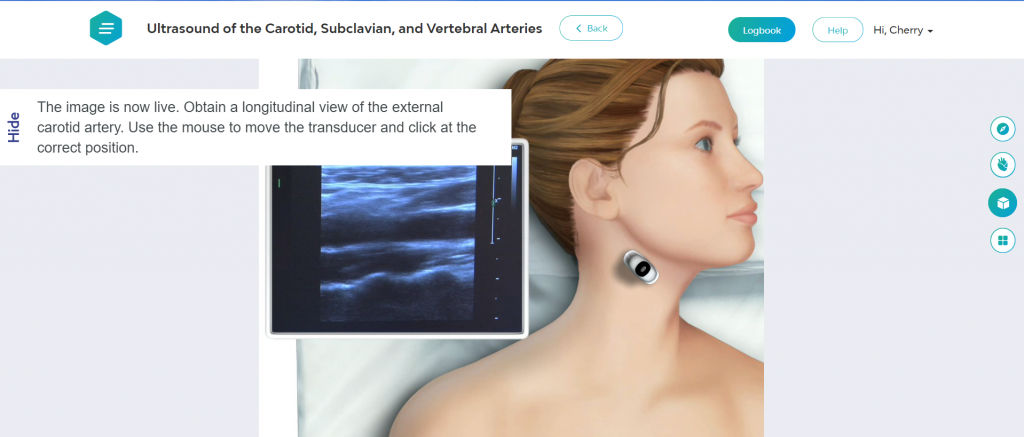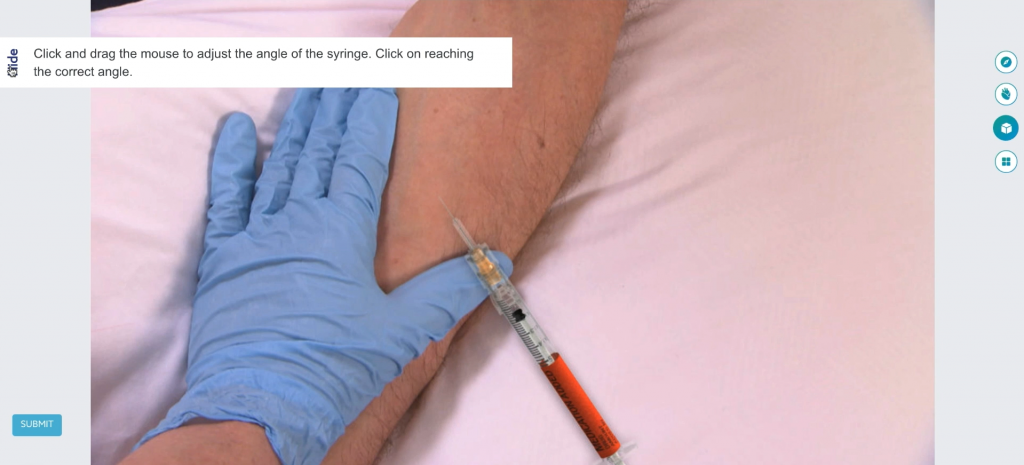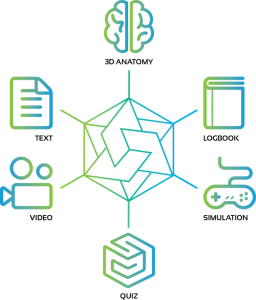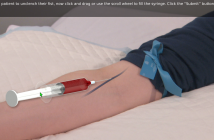Have you ever had a dream where you were sitting for an exam you were nowhere near ready for? Or maybe you dreamed you were onstage before an audience of hundreds, all waiting for you to sing a song you’d never rehearsed?
For students in the fields of allied health and medicine, these anxious dreams echo an all-too-familiar reality. And if you are one of these students, you know quite well the rigors of your chosen field: you are tasked with mastering some of the most complex and risk-laden material in higher education, and you’re required to do so quickly and often with minimal hands-on training or personalized instruction.

Speaker giving presentation in lecture hall at university. Students listening to lecture and making notes.
The reality is that class sizes in these fields are often large and the learning demands are high. A cohort in a medical school might be hundreds of students, with a punishing curriculum requiring them to absorb large quantities of complex information in a very short time before moving on to the next topic. Access to instructors may be limited, at best, while the availability of clinical practice equipment and spaces may be scarcer. Some allied health programs are accelerated, giving students only weeks to learn everything they need to know.
This means that as an allied health or medical student, you may routinely find yourself tasked with demonstrating mastery of a clinical skill with which you have scant experience. Your certificate, diploma or degree, even your licensure – and almost certainly your ability to secure a job – may hinge upon your ability to perform clinical tasks to which you’ve had little to no practical exposure. In other words, you may find yourself staking the entire ballgame on your ability to perform a procedure that you’ve thus far only watched on video or seen demonstrated from a distance in a crowded lab.
The Power of Virtual Simulation
No question about it: the picture painted above provides huge challenges for both learners and teachers. In a field where there’s competition for access to limited resources, highly-scheduled practice spaces and overworked instructors, it would seem as though the scorching spotlight of that “dream stage” would be an inescapable version of reality!
There is hope, and it lies in the vast and growing power of technology. More specifically, e-learning through the medium of virtual simulation is proving to be an enormously beneficial resource for students and professionals alike in allied health and medicine.
A growing body of literature suggests that virtual simulation profoundly outpaces traditional learning methods when it comes both to content knowledge and skill mastery.

The reason for this is simple: virtual simulation allows you, the learner, to not only watch a simulated procedure being performed in real time on a 3D virtual model but also to duplicate that procedure yourself, on the same model, without needing to be in a lab or a clinical setting. In fact, with web-based simulations, you can do your learning literally anywhere and any time. This revolutionary approach speaks to the highly complex processes involved in true learning, the multi-layered cognitions implicated in skill mastery.
Traditional learning methods are predicated upon the passive reception of knowledge and they principally involve only two cognitive processing centers: the aural and the visual. Students witness procedures being performed, they read about them in books, and they study images in texts or online. Rarely, however, do these traditional methods enlist the student as an active agent in the learning process. If and when students are invited to engage in a hands-on manner to perform the skills they are learning, it is often done in a high-stakes context, surrounded by peers and, often, under the critical eye of an evaluator.
Learning via virtual simulation, on the other hand, enlists all of the brain’s cognitive centers in the process of content and skill mastery. Research suggests that this form of cognitive learning is among the most powerful learning methodologies for most students, enabling them to actualize and apply the skills they had previously explored only in theory. Through virtual simulation, students are tasked not only to learn by passively seeing and hearing but also, and perhaps most significantly, to participate actively, engage their brains and learn by doing.
Research suggests that – apart from physical practice – this form of active, cognitive learning is among the most powerful learning methodologies for most students, enabling them to actualize and apply the skills they had previously explored only in theory. It also provides a powerful form of mental practice that allows learners to continue creating muscle memory after hands-on training. As students use virtual simulation to practice the steps and decisions required to perform clinical skills, the cognitive processing centers and the motor cortex of the brain generate the same nerve impulses that occur during the action itself, allowing these skills ultimately to be performed automatically (Bernardi et al., 2013; Ryan, 2016).

The SIMTICS Advantage
As the advantages of virtual simulation technologies become increasingly apparent in the fields of allied health and medical education, a host of new tools has begun to emerge to accommodate today’s growing demand for more healthcare professionals as the population ages and needs more care. Of the technologies currently available, however, perhaps none offers the efficacy, flexibility, and affordability of the SIMTICS suite of learning resources.
SIMTICS offers a pioneering array of learning modules to help you master a wide range of clinical skills, from catheterization to ultrasound scanning to instrument sanitization. With the SIMTICS learning modules, you can watch a skill being performed, listen to it being described, and then practice it in a risk-free virtual environment. And you can do this from anywhere—from the classroom to the privacy of your own home. No more vying for scarce practice spaces. No more practice runs on expensive and fragile equipment. No more asking the instructor to repeat a demonstration because you didn’t get a good enough view the first time or because you need more time to fully absorb the lesson.
With the SIMTICS simulations, you can watch all or a portion of a lesson as often as you need or want, and you can practice the skill until you feel confident in all the step. The SIMTICS modules are just as content-rich and responsive on your tablet or mobile device as they are on your home-based PC. This means that you can take your learning with you, as you focus on the skills that most concern you.
Best of all, this is learning that occurs on your own time, at your own pace, and according to your own needs, not those of your instructor or your classmates. Not only do you have the luxury of choosing what to focus on and when, but you also have the luxury of making mistakes without fear of judgment. Unlike traditional methods, where skills are practiced in the presence of both the instructor and perhaps dozens of peers, learning through SIMTICS virtual simulations can be done in private which alleviates the pressure of competition. And when you are free to mess up without fear of judgment, ridicule, or repercussion, you are also free to try, to push your learning further, to risk failure so that you can learn from your mistakes—often the most effective and enduring form of learning. Plus, as an individual learner, you are not consigned to a long-term contract with SIMTICS. You have the option to pay month-by-month and to purchase access only for the modules you want at any stage of your learning. Best of all, you can pause and resume the SIMTICS service at any time. No hassles and no fees.
SIMTICS’ holistic approach to learning, catalyzing your aural, visual, and kinesthetic processing faculties in combination, ensures its efficacy for the most diverse student populations. So,no matter your preferred learning style or depth of content experience, virtual procedure simulation accommodates your particular learning needs, maximizing your achievement.
Cost and Flexibility
Not only are the SIMTICS learning modules among the most advanced and effective learning tools currently available on a standard laptop or mobile device, they are also among the most affordable. You can pay for only the modules that you need, as you need them.
For example, if you are interested in learning a single clinical skill, you have the option to purchase one learning module for an average cost of less than $10 for a full month’s unlimited access. And with your purchase comes a complimentary certificate of completion once you have successfully completed the module with its embedded test simulations.
On the other hand, if you’re seeking a more comprehensive set of learning resources, SIMTICS offers a full suite of modules at an affordable price. For $60 or less per month, you can purchase unlimited access to the full library of SIMTICS learning modules in your area of interest.
If you want to take a break from your studies for a time, you can easily suspend your subscription, then resume later, if and when you are ready. In other words, you pay only for the months you want and for the content you want. Or for the serious learner, you can save by purchasing a comprehensive plan which gives you a full 12 months access for a price that’s less than 5 monthly subscription payments.
Because SIMTICS is completely modular, it allows you the flexibility to select and study only the skill(s) you want, when you want – and you don’t have to be enrolled in a formal education program to benefit. SIMTICS’ modules are just as effective for the working professional seeking to learn a new skill or brush up on an old one as they are for the novice practitioner, the student taking up a transducer, syringe, or catheter for the first time, or the job-seeker wanting to keep their skills fresh after graduation.
The flexibility of the SIMTICS catalogue and pricing plan allows you to design the learning strategy that best suits your study schedule or professional goals both now and in the future.
The Takeaway
Medical and allied health education is changing. In an era of increasing competition and dwindling resources, to be successful, students need more than meager clinical practice time and the divided attention of busy instructors. They need the opportunity to study and practice challenging clinical skills anytime, anywhere, and take the time they need. They need the gift of being able to study, to learn, and to master difficult techniques through on-demand practice. They need to be able to achieve mastery through repetition and build excellence through doing—no matter when, how long, or how many times it takes.
SIMTICS provides exactly that. By harnessing the power of virtual simulation, SIMTICS offers learning by doing, learning that is holistic and enduring. This is multi-modal education through seeing, hearing, and action, combined. And it transforms you from a passive recipient of your instructor’s know-how into an active agent creating your own knowledge. With SIMTICS, you are able to customize your learning strategies to meet your most pressing needs and important goals. Through the power of repetition and low-pressure, guided practice, combined with the efficacy of multi-modal resources, you can take charge of your learning and become the driver of your own professional success.
The SIMTICS Advantage:
- Focus on only the topics you need
- Study whenever and wherever you choose
- Repeat difficult procedures and review complex material as often as you need
- Practice challenging skills in the privacy of your own home without the fear of making mistakes in the presence of instructors or peers
- Simulate procedures in real time, without having to compete for rare clinical space or equipment and instrument access
- No long-term commitments—purchase only the lessons you want, pay month-by-month if you want, and pause and continue your subscriptions at any time!
Source:
Bernardi, N. F., De Buglio, M., Trimarchi, P. D., Chielli, A., & Bricolo, E. (2013). Mental practice promotes motor anticipation: evidence from skilled music performance. Frontiers in human neuroscience, 7, 451. doi:10.3389/fnhum.2013.00451
Ryan, D. (February 2016). Cognitive simulation may help shorten surgical learning curve. Orthopedics Today Europe.





